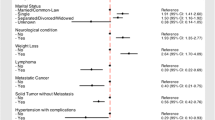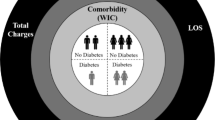Abstract
This research examines whether inpatients with common illnesses and comorbid heat-related illness (HRI) suffer worse health outcomes and use more hospital resources than similar patients without a diagnosed HRI. We used the Nationwide Inpatient Sample, 2001–2010 to compare outcomes, including inpatient length of stay, number of procedures, total charges, discharge status and death, for hospitalization of common illnesses with and without HRI. We used bivariate and multivariable regressions to identify risk factors for health outcomes among inpatients with common illnesses and comorbid HRI. Stratified analyses examined outcomes according to sociodemographics and hospital characteristics to further identify specific risk factors. Among inpatients with respiratory illnesses, negative outcomes were more frequent when a comorbid HRI was present. Additionally, inpatients with cardiac diseases showed increased mortality when a comorbid HRI was present. Overall, comorbid HRI was not associated with worse outcomes among the other common illnesses analyzed. While heat may precipitate hospital admissions for renal and diabetic conditions, these conditions have similar outcomes whether or not a HRI is present. However, comorbid HRI is associated with worse outcomes for respiratory illness hospitalizations and higher risk of death among cardiac disease hospitalizations.
Similar content being viewed by others
References
Anderson BG, Bell ML (2009) Weather-related mortality: How heat, cold, and heat waves affect mortality in the United States. Epidemiology 20(2):205–213
Anderson BG, Dominici F, Wang Y, et al. (2013) Heat-related emergency hospitalizations for respiratory diseases in the Medicare population. Am J Respir Crit Care Med 187(10):1098–1103
Argaud L, Ferry T, Le Q, et al. (2007) Short- and long-term outcomes of heatstroke following the 2003 heat wave in Lyon, France. Arch Intern Med 167(20):2177–2183
Balbus JM, Malina C (2009) Identifying vulnerable subpopulations for climate change health effects in the United States. J Occup Environ Med 51(1):33–37
Bedsworth L (2012) Air quality planning in California’s changing climate. Clim Chang 111:101–118
Bobb JF, Obermeyer Z, Wang Y, et al. (2014) Cause-specific risk of hospital admission related to extreme heat in older adults. JAMA 312(24):2659–2667
Bouchama A, Knochel JP (2002) Heat stroke. N Engl J Med 346(25):1978–1988
Cheng P, Gilchrist A, Robinson KM, Paul L (2009) The risk and consequences of clinical miscoding due to inadequate medical documentation: a case study of the impact on health services funding. Health Inf Manag 38(1):35–46
Costello A, Abbas M, Allen A, et al. (2009) Managing the health effects of climate change. Lancet and University College London Institute for Global Health Commission. Lancet 373(9676):1693–1733
Ebi KL, Meehl GA (2007) The heat is on: climate change and heatwaves in the Midwest. (Regional impacts of climate change: four case studies in the United States). Pew Center on Global Climate Change, Arlington
Hajat S, Armstrong BG, Gouveia N, et al. (2005) Mortality displacement of heat-related deaths: A comparison of Delhi, São Paulo, and London. Epidemiology 16(5):613–620
Hansen AL, Bi P, Ryan P, et al. (2008) The effect of heat waves on hospital admissions for renal disease in a temperate city of Australia. Int J Epidemiol 37(6):1359–1365
Harlan SL, Ruddell DM (2011) Climate change and health in cities: Impacts of heat and air pollution and potential co-benefits from mitigation and adaptation. Curr Opin Environ Sustain 3(3):126–134
Hausfater P, Megarbane B, Dautheville S, et al. (2010) Prognostic factors in non-exertional heatstroke. Intensive Care Med 36(2):272–280
Hayes D Jr, Collins PB, Khosravi M, et al. (2012) Bronchoconstriction triggered by breathing hot humid air in patients with asthma role of cholinergic reflex. Am J Respir Crit Care Med 185(11):1190–1196
HCUP (Healthcare Cost and Utilization Project) (2014) Overview of the national (nationwide) inpatient sample (NIS). http://www.hcup-us.ahrq.gov/nisoverview.jsp. Accessed 16 Nov 2014
Huang C, Barnett AG, Wang X, et al. (2011) Projecting future heat-related mortality under climate change scenarios: a systematic review. Environ Health Perspect 119(12):1681–1690
IPCC (Intergovernmental Panel on Climate Change) (2014) Climate change 2014: Impacts, Adaptation, and Vulnerability. Cambridge University Press, New York
Knowlton K, Rotkin-Ellman M, King G, et al. (2009) The 2006 California heat wave: Impacts on hospitalizations and emergency department visits. Environ Health Perspect 117(1):61–67
Kovats RS, Hajat S (2008) Heat stress and public health: a critical review. Annu Rev Public Health 29:41–55
Kovats RS, Hajat S, Wilkinson P (2004) Contrasting patterns of mortality and hospital admissions during hot weather and heat waves in greater London, UK. Occup Environ Med 61(11):893–898
Kravchenko J, Abernethy AP, Fawzy M, et al. (2013) Minimization of heatwave morbidity and mortality. Am J Prev Med 44(3):274–282
Lin S, Luo M, Walker RJ, et al. (2009) Extreme high temperatures and hospital admissions for respiratory and cardiovascular diseases. Epidemiology 20(5):738–746
Lin Y, Wang Y, Ho T, et al. (2013) Temperature effects on hospital admissions for kidney morbidity in Taiwan. Sci Total Environ 443:812–820
Loughnan ME, Nicholls N, Tapper NJ (2010) When the heat is on: Threshold temperatures for AMI admissions to hospital in Melbourne, Australia. Appl Geogr 30(1):63–69
LoVecchio F, Pizon AF, Berrett C, et al. (2007) Outcomes after environmental hyperthermia. Am J Emerg Med 25(4):442–444
Mastrangelo G, Fedeli U, Visentin C, et al. (2007) Pattern and determinants of hospitalization during heat waves: an ecologic study. BMC Public Health 7(1):200
McGeehin MA, Mirabelli M (2001) The potential impacts of climate variability and change on temperature-related morbidity and mortality in the United States. Environ Health Perspect 109(SUPPL2):185–189
McMichael AJ (2013) Globalization, Climate Change, and Human Health. N Engl J Med 368:1335–1343
Meehl GA, Tebaldi C (2004) More intense, more frequent, and longer lasting heat waves in the twenty-first century. Science 305:994–997
Mireku N, Wang Y, Ager J, et al. (2009) Changes in weather and the effects on pediatric asthma exacerbations. Ann Allergy Asthma Immunol 103(3):220–224
O'Neill MS, Zanobetti A, Schwartz J (2003) Modifiers of the temperature and mortality association in seven US cities. Am J Epidemiol 157(12):1074–1082
O'Neill MS, Hajat S, Zanobetti A, et al. (2005) Impact of control for air pollution and respiratory epidemics on the estimated associations of temperature and daily mortality. Int J Biometeorol 50(2):121–129
O'Neill MS, Carter R, Kish JK, et al. (2009) Preventing heat-related morbidity and mortality: New approaches in a changing climate. Maturitas 64(2):98–103
Peterson TC, Heim RR, Hirsch R, et al. (2013) Monitoring and understanding changes in heat waves, cold waves, floods, and droughts in the United States: state of knowledge. Bull Am Meteorol Soc 94(6):821–834
Reid CE, Gamble JL (2009) Aeroallergens, allergic disease, and climate change: impacts and adaptation. EcoHealth 6(3):458–470
Rice MB, Thurston GD, Balmes JR, et al. (2014) Climate change a global threat to cardiopulmonary health. Am J Respir Crit Care Med 189(5):512–519
Russo S, Dosio A, Graversen RG, et al. (2014) Magnitude of extreme heat waves in present climate and their projection in a warming world. J Geophys Res Atmos 119(22):12,500–12,512
Schmeltz MT, Sembajwe G, Marcotullio PJ, et al. (2015) Identifying individual risk factors and documenting the pattern of heat-related illness through analyses of hospitalization and patterns of household cooling. PLoS One 10(3):e0118958
Semenza JC, McCullough JE, Flanders WD, et al. (1999) Excess hospital admissions during the July 1995 heat wave in Chicago. Am J Prev Med 16(4):269–277
Semenza JC, Ploubidis GB, George LA (2011) Climate change and climate variability: personal motivation for adaptation and mitigation. Environ Health 10:46
Sheffield PE, Durante KT, Rahona E, et al. (2014) Emerging roles of health care providers to mitigate climate change impacts: a perspective from East Harlem, New York. Health Hum Rights 16(1):113–121
Stafoggia M, Schwartz J, Forastiere F, et al. (2008) Does temperature modify the association between air pollution and mortality? A multicity case-crossover analysis in Italy. Am J Epidemiol 167(12):1476–1485
US Census Bureau (United States Census Bureau) (2010) 2010 census urban and rural classification and urban area criteria. https://www.census.gov/geo/reference/ua/urban-rural-2010.html. Accessed Apr 14, 2013
Varghese GM, John G, Thomas K, et al. (2005) Predictors of multi-organ dysfunction in heatstroke. Emerg Med J 22(3):185–187
Wallace RF, Kriebel D, Punnett L, et al. (2007) Prior heat illness hospitalization and risk of early death. Environ Res 104(2):290–295
Yardley JE, Stapleton JM, Sigal RJ, et al. (2013) Do heat events pose a greater health risk for individuals with type 2 diabetes? Diabetes Technol Ther 15(6):520–529
Acknowledgments
M.S. is a participant in the ASPPH/EPA Environmental Health Fellowship (Class of 2015). However, the work conducted for this publication was completed prior to the fellowship and has no relationship to the fellowship whatsoever and was not funded by ASPPH or EPA.
Author information
Authors and Affiliations
Corresponding author
Electronic Supplementary Material
10584_2016_1747_MOESM1_ESM.docx
Online Table 1 (DOCX 18 kb)
10584_2016_1747_MOESM2_ESM.docx
Online Table 2 (DOCX 16 kb)
10584_2016_1747_MOESM3_ESM.docx
Online Table 3 (DOCX 17 kb)
Rights and permissions
About this article
Cite this article
Schmeltz, M.T., Marcotullio, P.J., Himmelstein, D.U. et al. Outcomes of hospitalizations for common illnesses associated with a comorbid heat-related illness in the United States, 2001–2010. Climatic Change 138, 567–584 (2016). https://doi.org/10.1007/s10584-016-1747-5
Received:
Accepted:
Published:
Issue Date:
DOI: https://doi.org/10.1007/s10584-016-1747-5




